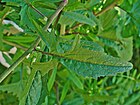Note: This is a project under development. The articles on this wiki are just being initiated and broadly incomplete. You can Help creating new pages.
Sisymbrium officinale - Hedge mustard
Hedge mustard is a plant in the family Brassicaceae. It is found on roadsides and wasteland, and as a weed of arable land. A native of Europe and North Africa, it is now well-established throughout the world.
Contents
- 1 Uses
- 2 Parts Used
- 3 Chemical Composition
- 4 Common names
- 5 Properties
- 6 Habit
- 7 Identification
- 8 List of Ayurvedic medicine in which the herb is used
- 9 Where to get the saplings
- 10 Mode of Propagation
- 11 How to plant/cultivate
- 12 Commonly seen growing in areas
- 13 Photo Gallery
- 14 References
- 15 External Links
Uses
Loss of the voice, Throat complaints, Heart problems, Common cold, Remedy for gout, Dampening effect on cough, Bronchitis, Diarrhea, Sore throats
Parts Used
Chemical Composition
Isopropyl isothiocyanate, 2-methylpropanenitrile, (Z)-hex-3-en-1-ol, sec-butyl isothiocyanate, (E)-hex-2-enal, (Z)-hex-2-en-1-ol, octanoic and dodecanoic acid, 2-methylbutanenitrile, dibutyl phthalate, and ethyl linolenate.[1]
Common names
| Language | Common name |
|---|---|
| Kannada | |
| Hindi | |
| Malayalam | |
| Tamil | |
| Telugu | |
| Marathi | NA |
| Gujarathi | NA |
| Punjabi | NA |
| Kashmiri | NA |
| Sanskrit | |
| English | Hedge Mustard, Wild mustard |
Properties
Reference: Dravya - Substance, Rasa - Taste, Guna - Qualities, Veerya - Potency, Vipaka - Post-digesion effect, Karma - Pharmacological activity, Prabhava - Therepeutics.
Dravya
Rasa
Tikta (Bitter), Kashaya (Astringent)
Guna
Laghu (Light), Ruksha (Dry), Tikshna (Sharp)
Veerya
Ushna (Hot)
Vipaka
Katu (Pungent)
Karma
Kapha, Vata
Prabhava
Habit
Identification
Leaf
| Kind | Shape | Feature |
|---|---|---|
| Simple | alternate | The leaves are compound i.e. made up of two or more discrete leaflets |
Flower
| Type | Size | Color and composition | Stamen | More information |
|---|---|---|---|---|
| Unisexual | 2-4cm long | Yellow | 5-20 | There are two or more ways to evenly divide the flower |
Fruit
| Type | Size | Mass | Appearance | Seeds | More information |
|---|---|---|---|---|---|
| General | 7–18 mm | the fruit is dry and splits open when ripe | many | {{{6}}} |
Other features
List of Ayurvedic medicine in which the herb is used
Where to get the saplings
Mode of Propagation
How to plant/cultivate
An easily grown plant, it succeeds in most soils but prefers a moist to dry acid to alkaline soil in full sun or light shade[3]
Commonly seen growing in areas
Hedge banks, Uncultivated ground, Waste ground.
Photo Gallery
References
External Links
- Ayurvedic Herbs known to be helpful to treat Loss of the voice
- Ayurvedic Herbs known to be helpful to treat Throat complaints
- Ayurvedic Herbs known to be helpful to treat Heart problems
- Ayurvedic Herbs known to be helpful to treat Common cold
- Ayurvedic Herbs known to be helpful to treat Remedy for gout
- Ayurvedic Herbs known to be helpful to treat Dampening effect on cough
- Ayurvedic Herbs known to be helpful to treat Bronchitis
- Ayurvedic Herbs known to be helpful to treat Diarrhea
- Ayurvedic Herbs known to be helpful to treat Sore throats
- Herbs with Leaves used in medicine
- Herbs with Seeds used in medicine
- Herbs with common name in English
- Habit - Annual plant
- Index of Plants which can be propagated by Seeds
- Herbs that are commonly seen in the region of Hedge banks
- Herbs that are commonly seen in the region of Uncultivated ground
- Herbs that are commonly seen in the region of Waste ground
- Herbs
- Brassicaceae






